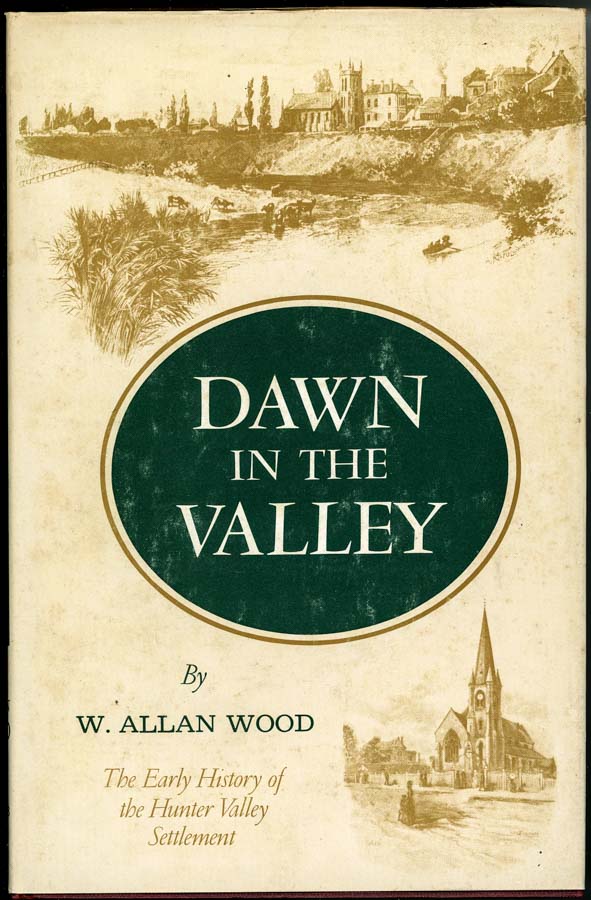Dawn in the Valley
Featured Image: ‘Dawn in the Valley’ by W. Allen Wood. ISBN 0 85587 027 3 Printed by Wentworth Books Pty Ltd 1972
See also: Dawn in the Valley: The Early History of the Hunter Valley Settlement by Allan Wood | Goodreads
Living History Audio:
This is another rare to find Australian historical book about the Hunter Valley, you might find it in the genealogy sections of libraries (not for loan usually), or at the Mitchell Library.
Many old historical books of Australia are pretty dry chaff to read through but W. Allan Woods’s exact and meticulous narrative shines like the light of wild poetry, as the daylight shone through the cedar forests he writes about. It is a moving history full of cruelty and homely strength and vigour.
The book documents from around 1804 to about the late 1840’s on the Coal River & environs (later named the Hunter River/ Hunter Valley). There is an incredible wealth of information for the genealogist & those seeking clues about their convict & colonial ancestors. My particular interest in this book stems from information within about my mother’s great great great grandmother Martha & how she arrived here in Australia and so I been able to fill in one branch of my multicultural family tree.
I was at first disappointed to find that she was English (having grown up with the belief most of my ancestors were either Irish, French, other European or Indigenous)& that the English the cause of all our troubles… but when I chanced upon her story I was surprised. People came to the antipodes for many different reasons actuated by various circumstances or in pursuit of individual goals: driven by a compelling wind or cast up like driftwood in the tide. Free immigrants, like convicts were of varying backgrounds and dispositions. Other people’s ancestor stories may not be of interest to everyone but Martha’s disposition and unquenchable courage and the tale of her love story probably demands a novel on it’s own. I was probably lucky to stumble upon it as my immediate family had no knowlege of it at the time.
Martha Sadleir (Sadler) daughter of a Knight Banneret (descent from one of the most powerful Tudors of England (Sir Ralph Sadleir) fell in love & eloped in 1823 with with John Elliott, mere Blacksmith whose father was a miller in Northumberland. Martha was disinherited and never forgiven by the family. Elliot was blacklisted and unable to obtain work of any kind in England. Finally through friendships and many requests John was employed by Thomas Potter Macqueen for his venture to New South Wales to transport emigrants, stock equipment and stores desperately needed in the colony. Macqueen’s venture was the largest individual investment to leave England up to that time. Martha, John and their newly born daughter Margaret sailed on the “Hugh Crawford” and arrived in Sydney in 1825.
The Hunter area was still wild & largely unexplored, and this was Macqueens’ area of interest. Mostly on foot and in wagons the party travelled through swamps and dense forests to Segenhoe (Upper Hunter). Martha was one of three white women to brave the area, and she the only one who survived there seven years in a mud and slab hut giving birth to several children much of the time alone as John acted as courier for Macqueen between Sydney and the Hunter. Martha befriended the local Aboriginal tribe the Kamilaroi who were fierce warriors and she did act as interpreter and learnt many of their local medicines. Years later the Elliot’s moved their base to Maitland and Morpeth; new towns being settled, and John was involved in the building of various mills.
The book details many of their adventures and those of other settlers and ticket of leavers, & all who ventured into the Hunter- there’s a wealth of information for those looking for family tree clues. While I did gloss over chapters that had little info about my ancestors it is a highly readable history. It’s not dry – the characters are fleshed out, human in all their failings and endeavours and the sources are researchable.
For me it was uplifting to find documentation that these English ancestors of mine were courageous, honest & treated the Aboriginals with dignity unlike some other accounts of settlers. The love story was a bonus.
Personal Perspective
I was born at the tiny village of Hepple, only 6 miles from Rothbury, Northumberland, England. I am intimately familiar with where John Elliott toiled as a miller and early engineer. The story of the Elliott family is inspiring. John and Martha produced 12 children all of whom survived, and all became grandparents themselves. I know Segenhoe very well indeed, the original ‘selection’ of Thomas Potter Macqueen.
“Dawn lingered in the Valley. The brightness of the morning was obscured by clouds of depression and insecurity, ignorance and injustice, discord, enmity and malignancy. In this hard country courage was everywhere, and in some great hearts was faith which could move mountains and would lift the clouds”. Wallis Plains (Maitland) 1852.










